In recent years, HR KPIs (Key Performance Indicators) have taken on an increasingly important role in human resources management.
These indicators provide real-time data on the HR performance of an entire organization, enabling the creation of targeted, relevant action plans.
Often centralized on the HR dashboard offered by HRIS software, KPIs provide visibility on the status, evolution and effectiveness of talent management within your company.
Why Use KPIs?
Before you discover what examples of KPIs are essential to your company, you may ask yourself why you should use KPIs in your HR department.
Here’s a list of benefits that Human Resources KPIs have to offer:
- Saving time and efficiency;
- Helping you make decisions or shape your HR decisions;
- Supporting your insights with numbers;
- Obtaining clear statistics and putting them to good use;
- Getting a comparative vision of indicators over time (evolution and efficiency over a period of time);
- Optimizing recruitment, training, and many other HR tasks;
- Identifying HR management problems in your company.
As you can see, KPIs are a valuable daily help and a powerful tool for human resource metrics and management.
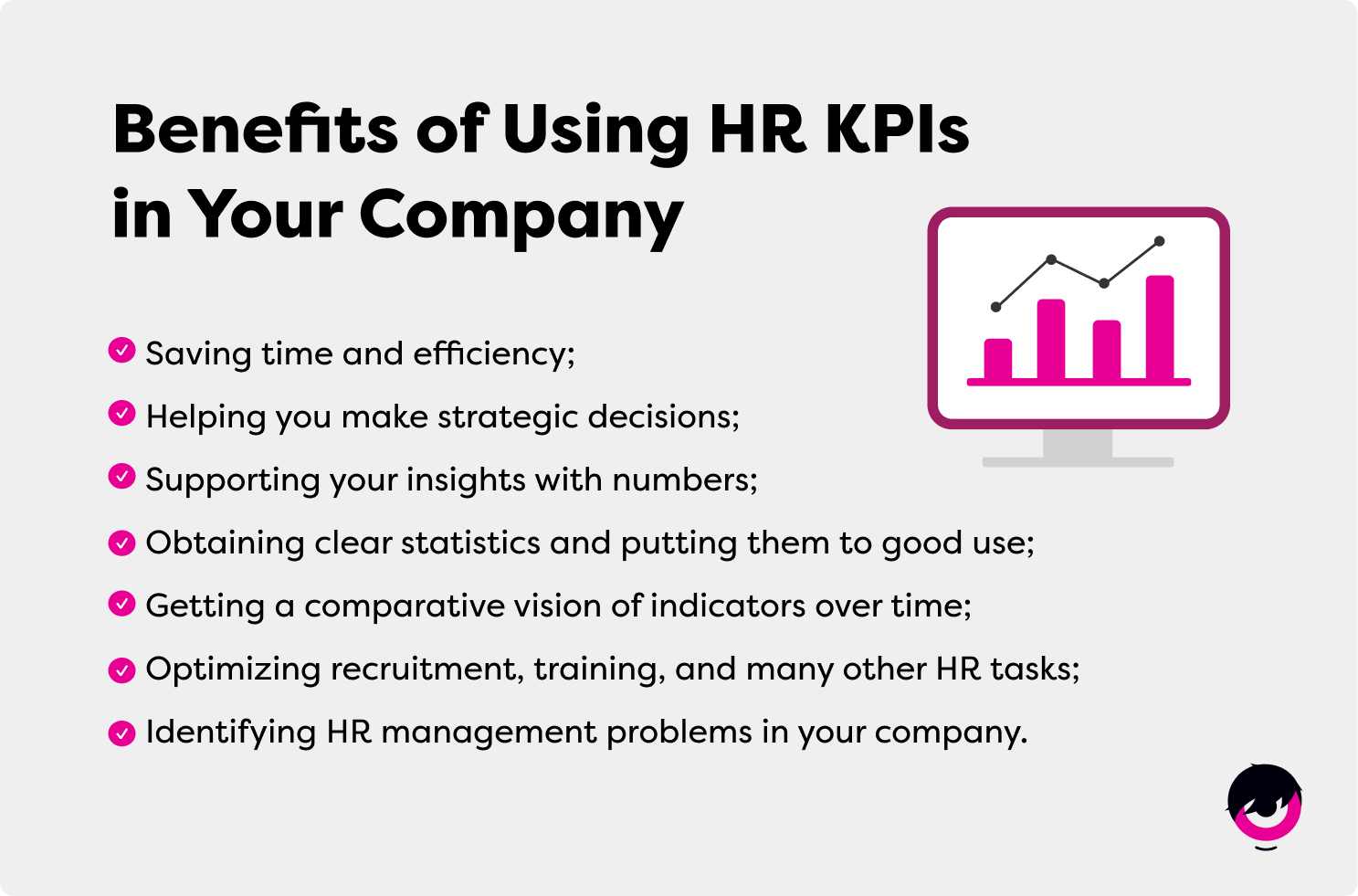
How Can You Use KPIs in Your Company?
Are you beginning to be sold on the benefits of KPIs but still need to learn how to use them? Here are the answers to all your questions.
First, let’s talk about implementation. Rest assured; you don’t have to come up with all the performance statistics yourself: KPIs can be effortlessly implemented within your organization.
Choosing a Human Resources Information System (HRIS) for your company will allow you to set up the indicators immediately. The calculations will start as soon as they are implemented and evolve over a period of time.
Afterwards, it will be up to you to use the statistics obtained to establish or optimize your HR plans and define strategic goals to improve your business strategy. Furthermore, using these indicators over the long term will allow you to measure the effectiveness of HR actions over a reference period and to continually improve your key business objectives accordingly.
It’s as simple – and as convenient – as that!
Which Key HR Metrics Are Essential for Efficient HR Management?
We have gathered the most critical employee performance indicators that you need to use on a daily basis. These core performance indicators reveal issues that have a profound impact on the running of a business and address various concerns such as employee retention, workplace and workforce safety, recruitment KPIs, and much more.

1. Employee Turnover Rate
The staff turnover rate corresponds to the number of employee departures in relation to the total number of employees in the company over a specific period.
It is a critical metric that allows you to identify the reasons for employee departures and identify voluntary departures. They indicate more precisely the reasons for employee departures in a dedicated module. Therefore, all these indicators are crucial to identifying problems related to the loss of workers in your company and acting strategically to stem the tide of departures.
To go even further in this analysis, we can also identify skilled employees (who have more strategic positions in the organization and are more difficult to replace) and their voluntary turnover rate. Since the departure of experienced employees is extremely costly and time-consuming for your company, this KPI will quickly become the pillar of your HR performance optimization plan.
Therefore, the voluntary turnover rate is an essential performance indicator to improve your business model, especially in the current context of the labor shortage in Canada.
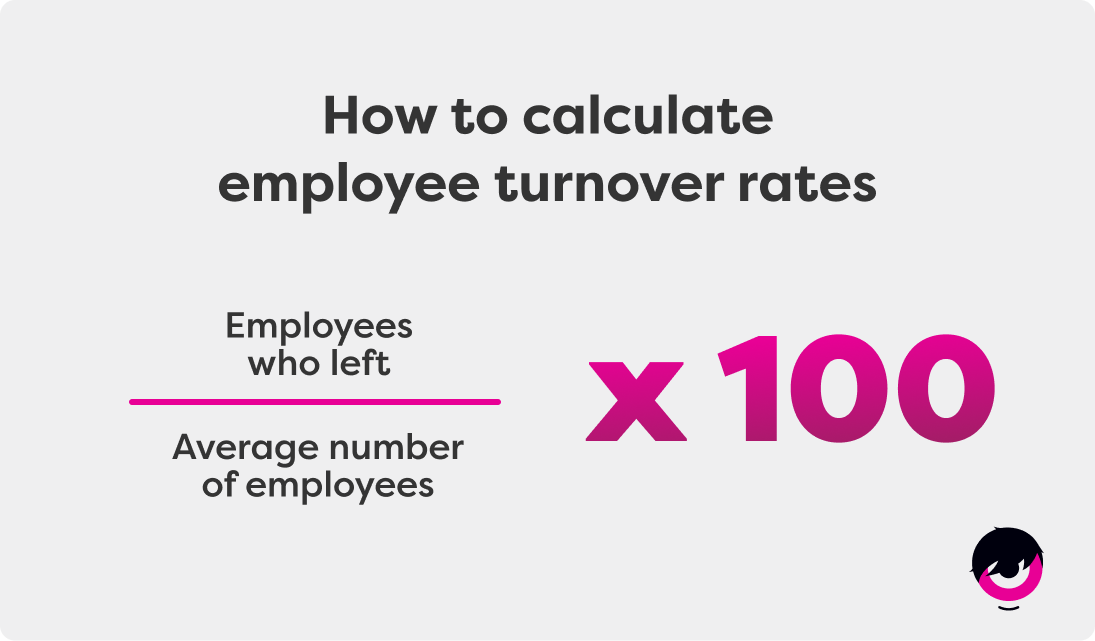
2. Absenteeism Rate
If you perceive situations of absenteeism in your company, this indicator is made for you. Indeed, it will support your impressions with clear statistics so that you can make the best decisions to solve these problems. In addition, it is an excellent indicator to quickly obtain data on days of absence and frequency of absences per employee.
Even if you don’t think you have a high absenteeism level in your organization, this performance indicator will offer you, in addition to a statistical value, a clear vision of the reasons given by employees to justify their absences. Absenteeism is always a consequence of other problems that will be easier to solve later on.
This KPI will lead you to work on other notions strategically, but in the meantime, you will have saved time in identifying the specific issues and employees involved.

3. Workplace Accidents
This KPI is useful in the construction and manufacturing industries. It makes it easy to track work-related accidents and store information related to their severity and the days of absence they cause.
Workplace accidents are a source of loss for the company and can indicate material or safety concerns in the workplace. If they are frequent, they will be detrimental to employees and the organization. This KPI can even indicate the frequency rate of these accidents to identify the seriousness of the situation and help reduce workplace accident rates.
4. Retention Rate
The retention rate corresponds to the percentage of employees who remain employed over a specific time and is currently a hot topic in HR. Labor shortages and the cost of losing qualified employees make this KPI essential to efficient human resources management.
Retention rates encompass the ability to retain employees over the long term and the success of an organization’s recruitment process. It also allows you to track your ability to retain new employees and determine whether your company attracts newcomers. Using this KPI can lead you to rethink your onboarding processes for new hires and your talent management and recruitment strategy. In a world where good employees are hard to find and even harder to keep, it is crucial to know the retention rate statistics in your company.
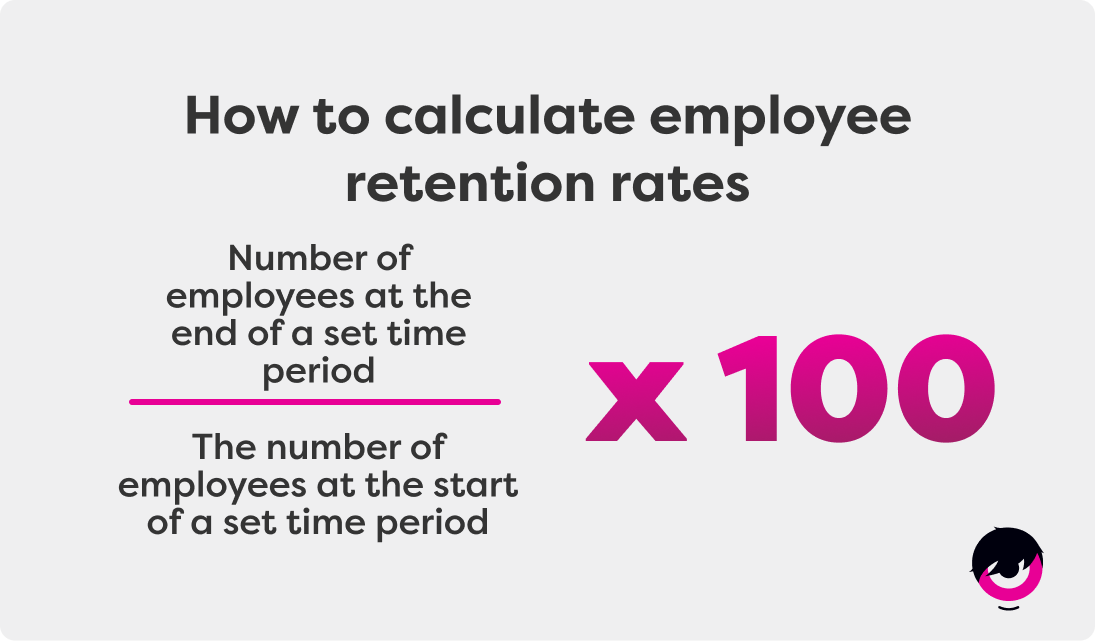
5. Demographics
Demographics aren’t strategic metrics per say, but they give you a clear picture of who your current employees are and what categories they fall into (job categories, diversity rate, for example). The purpose here is not to categorize your employees and their personal data for no apparent reason, but to access information that is essential for business intelligence.
It will be a useful indicator to complete annual insurance reports, government reports, etc. Demographic data can also help you make decisions about your organizational strategy. Although it is not a management indicator, it will help you weigh some of your company goals.

Complete List of HR KPIs by Type
Recruitment Indicators
Hiring the right person can be time-consuming, costly and complex for your HR department and recruiters. To determine the efficiency of your recruitment processes, you can track and analyze the following indicators:
- Average cost per hire: this indicator takes into account both internal and external recruitment costs, to give you a clear picture of the budget invested in each hire.
- Time per recruitment: calculation of the time spent on recruitment, from the publication of the job offer to the new hire’s onboarding process.
- New hire turnover rate: helps you determine whether you are able to motivate and retain your new recruits after their probationary period and over a defined period of time.
- Diversity in recruitment: gives you an overview of the various profiles that have joined your company (age, gender, nationality, professional background).
- Equity in recruitment: you can track the gender profile of your recruits and determine whether you are hiring women for higher positions.
- Offer acceptance rate: this indicator helps you determine whether your job offers and recruitment practices are effective, and whether you are succeeding in convincing candidates to join your company.
- Candidate satisfaction rate: you can send surveys to candidates and measure their level of satisfaction with your recruitment process.
- Hire retention rate: in the same way, you can survey your new employees on your recruitment and onboarding processes to determine if they are effective.
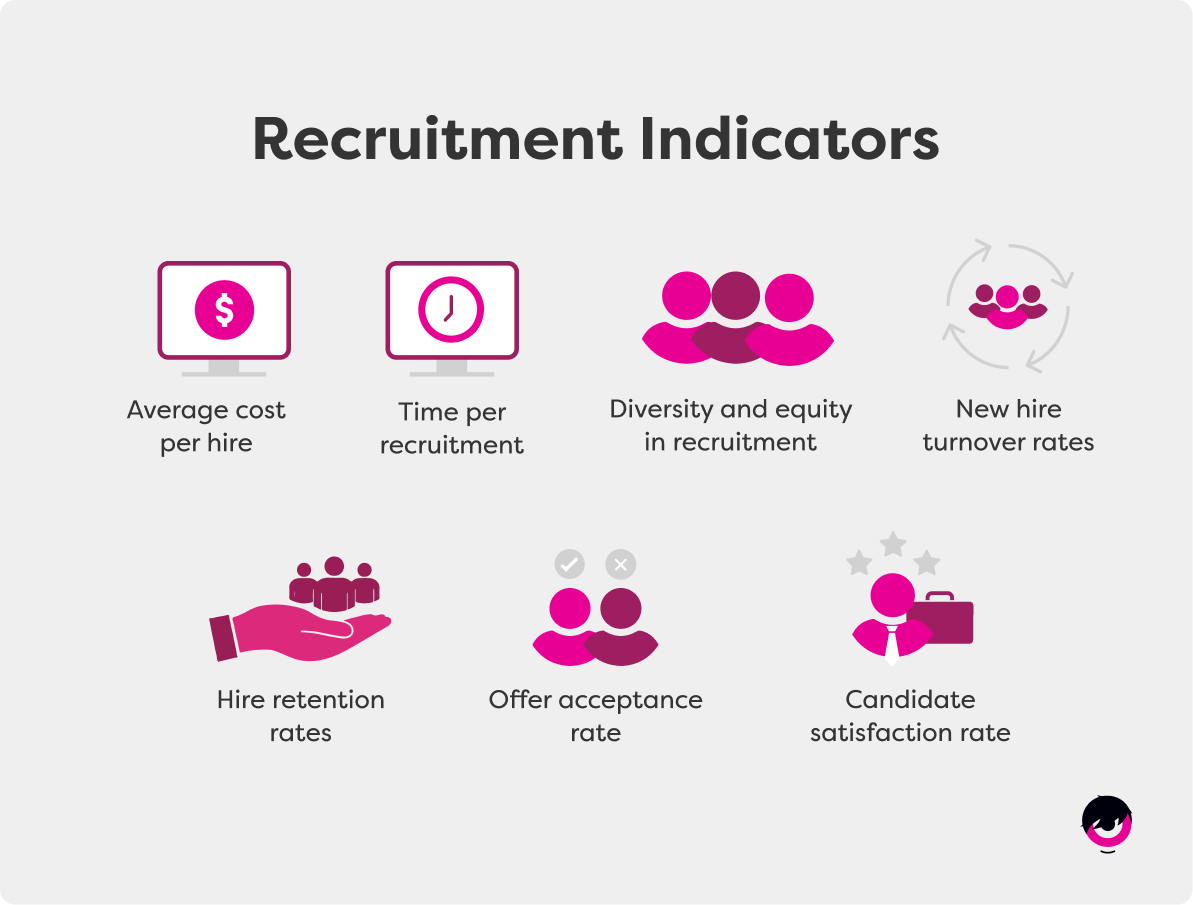
Demographics Indicators
Indicators linked to the demographics of your teams can be interesting for building EDI (Equity, Diversity and Inclusion) plans and for anticipating your talent acquisition and management needs:
- Average age of employees: this indicator enables you to visualize the different age brackets that make up your company, and which positions are occupied predominantly by different generations of workers.
- Gender information: gives you an overview of the genders that make up your organization, and which role they have in the company.
- Type of employment contract: find out how many temporary workers, permanent employees and trainees are present in your organization.
- Workplace conflicts and accidents: tracking the frequency of workplace conflicts or accidents enables you to identify situations that are potentially toxic or detrimental to the integrity and health of your employees and to solve them as effectively as possible.
Indicators on HR Performance and Productivity
Of course, HR KPIs also enable you to monitor your day-to-day efficiency, productivity and performance:
- Productivity ratio: corresponds to the company’s sales divided by its number of employees, and gives you an estimate of productivity per employee.
- Goal achievement rates: allows you to track the achievement of individual or team objectives set during performance appraisals.
- Payroll: evaluates the evolution of your payroll over time.
- Overtime: indicates the number and frequency of overtime hours worked per team or per employee.
Training and Development Indicators
You can track the time and budget dedicated to employee development programs and improve your teams’ satisfaction and productivity levels by analyzing the following KPIs:
- Training costs: this KPI gives you the opportunity to keep an eye on the costs invested in training your teams.
- Training hours: gives you an overview of the number of training hours allocated over a selected period.
- Internal promotion rates: you can keep track of internal mobility and its frequency within the company.
- Training success rates: to ensure the relevance of the training offered to your employees, you can track their success rates and their satisfaction with the learning opportunities they received.
Employee Satisfaction Indicators
If you want to retain your talent, implement effective engagement strategies, and gain insight into the quality of your employer brand and work environment, we recommend tracking the following KPIs:
- Employee turnover rate: indicates the number of employees who have left your company over a defined period and can differentiate voluntary turnover from other types of departure.
- Employee retention rate: in contrast, the retention rate underlines your ability to retain employees over a given period.
- Satisfaction rate: is measured by considering satisfaction with the work environment, benefits, events, training, employee wellness programs and overall compensation you offer your teams.
- ENPS (Employee Net Promoter Score): this KPI defines the likelihood of your employees recommending your organization to candidates or friends, taking into account the quality of your working environment, their motivation and their cultural alignment with company.
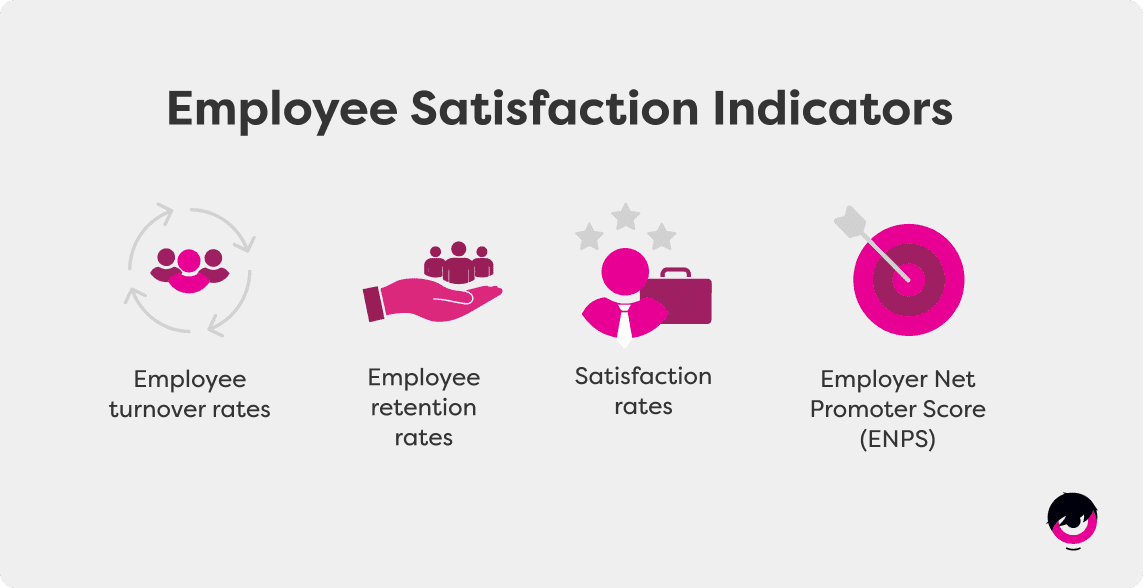
Frequently Asked Questions
How do I choose the most relevant HR KPIs for my company?
Performance indicators are numerous and diverse, and it’s not always appropriate to track them all at the same time. Depending on your company’s needs and reality, you’ll need to select specific KPIs that will support your business goals.
For example, if you notice high employee turnover rates within your company, you should prioritize monitoring this KPI and related indicators (employee and new hire satisfaction rates, productivity and performance, etc.). By cross-analyzing the relevant indicators, you can create effective retention strategies that target the departments or individuals experiencing by high turnover rates.
How often should I evaluate HR KPIs?
If you use the right automation and data centralization tools, your HR KPIs will be updated automatically on your platform. It’s up to you to decide how often you should evaluate your indicators, depending on the urgency and nature of your needs.
If you have many HR issues to solve in your organization, a monthly analysis may be necessary. If you’re in the midst of an HR transformation process, or planning to present HR reports to stakeholders, a quarterly frequency may be appropriate for you. If you want to carry out a one-off organizational diagnosis, you can update your KPIs annually.
What tools or software solutions can help you track HR KPIs?
HR software solutions with KPI features help you measure indicators and build HR reports depending on your needs and strategies.
HRIS often offer dashboards centralizing the indicators you are currently tracking, your demographic data and current rates you need to follow.
Calculating KPIs by hand takes a lot of time and energy, and can lead to mistakes that will have a negative impact on your strategic HR management. Folks HR offers flexible and powerful HR KPI features – discover them all today!
What are the common mistakes to avoid?
Here are the main mistakes to avoid when tracking your KPIs:
- Tracking too many KPIs at once: you don’t have to track every existing indicator at the same time. Instead, focus on the KPIs that can make all the difference to the HR strategies you are currently prioritizing.
- Not analyzing KPIs in depth: tracking KPIs is great, but you need to use them strategically to spot problems and solve them later on.
- Calculating KPIs by hand: calculating KPIs by hand leads to human error and wasted time and resources. Use the right automated tools to ensure you get the best results, so you can focus on the strategic dimension of your role.
- Focusing only on KPIs: figures and data are essential to support your feelings. However, you also need to rely on instinct and discussions you had with employees and managers to identify complex human issues Key Performance Indicators cannot spot.

HR performance indicators are essential tools for optimizing your strategy, enabling you to make decisions that are relevant and adapted to your company’s needs and issues.
They are playing an increasingly important role in organizations, and are destined to become more diversified and widespread in the future.
Of course, they do not replace the human and empathetic dimension you need for effective talent management, but they do guide your HR strategies to improve the well-being and productivity of your teams.
To benefit from real-time updates on all your key performance indicators, implement Folks HR reporting solution today!
Do you want to discover the impact of human resources KPIs on your organizational strategy?
Reach your business goals with Folks HR!

